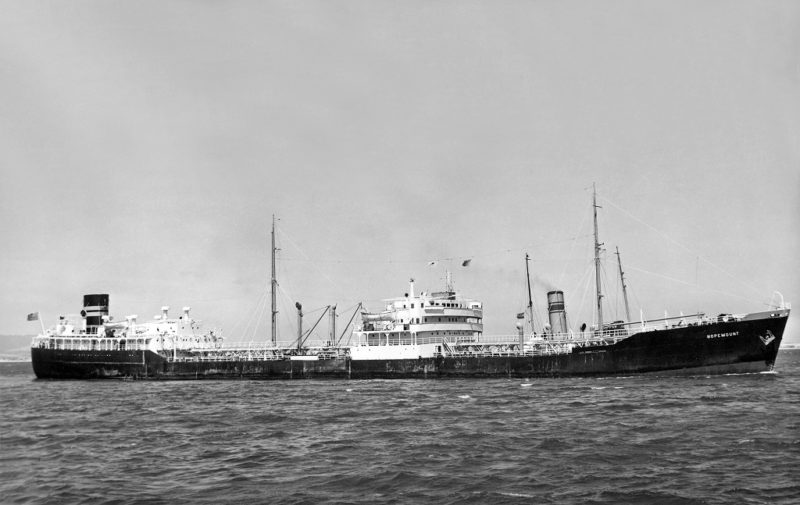
This company was formed on 21st June 1904 with a subscribed capital of £12,000 with the vast majority of the shares held by shipbuilder Swan, Hunter & Wigham Richardson Ltd. with the objective of trading ‘spec’ ships built by them. Stamp, Mann & Co. were appointed managers of the first tramp Hopemount which was ready at the Wallsend yard in September 1904. A bank mortgage of £23,712 was taken out to provide the rest of the construction cost of £35,954. Hopemount was of 3,300 gross tons and 5,000 dwt and was a quite conventional three island tramp with five holds with no. 3 hold being the cross bunker hold between bridge and engineer accommodation. The centre island was extended to include no. 4 hatch and no. 5 hatch was in a well-deck. Hopemount was to make 43 voyages up to the outbreak of WWI, and since she was the only owned ship these voyages produced the following profits:-
Trading Profit Net Profit Dividend
1904/05 £2,259 £719 5%
1905/06 £3,911 £2,603 6%
1906/07 £2,027 £1,133
1907/08 £1,831 £712
1908/09 £37 (£901)
1909/10 £1,899 £770
1910/11 £3,213 £1,765 5%
1911/12 £8,711 £4376 10%
1912/13 £8,201 £4128 10%
1913/14 (£1,089) (£1,267)
The cyclical nature of tramp trading is clearly shown, and the 43 voyages with many on the ‘Eternal Triangle’ to the Black Sea are now given in detail:-
- 23.9.1904 Tyne (coal), Genoa, Sulina & Mustendje (grain), Antwerp.
- 17.12.1904 Tyne (ballast), San Lorenzo & Plate (grain), Liverpool.
- 19.3.1905 Barry (coal), Marseilles, Newport.
- 18.4.1905 Newport (coal), Marseilles, Bona, Rotterdam, Tyne.
- 10.6.1905 Tyne (ballast), Rosario (grain), Las Palmas, Hamburg.
- 25.9.1905 Barry (coal), Marseilles, Sulina (grain), Antwerp.
- 11.12.1905 Barry (coal), Las Palmas, Galveston (grain), Belfast.
- 24.3.1906 Barry (coal), Civitavecchia, Sulina (grain), Antwerp.
- 23.9.1904 Tyne (coal), Genoa, Sulina & Mustendje (grain), Antwerp.
- 17.12.1904 Tyne (ballast), San Lorenzo & Plate (grain), Liverpool.
- 19.3.1905 Barry (coal), Marseilles, Newport.
- 18.4.1905 Newport (coal), Marseilles, Bona, Rotterdam, Tyne.
- 10.6.1905 Tyne (ballast), Rosario (grain), Las Palmas, Hamburg.
- 25.9.1905 Barry (coal), Marseilles, Sulina (grain), Antwerp.
- 11.12.1905 Barry (coal), Las Palmas, Galveston (grain), Belfast.
- 24.3.1906 Barry (coal), Civitavecchia, Sulina (grain), Antwerp.
- 23.6.1906 Newport (coal), Savona, Sulina (grain), Marseilles, Sulina (grain), Antwerp.
- 16.11.1906 Tyne (coal), Mobile (cotton), Bremerhaven.
- 11.2.1907 Cardiff (coal), Porto Ferraio, Tampa & New Orleans (grain), Hamburg.
- 14.6.1907 Barry (coal), Naples, Novorossisk (grain), Brake.
- 8.9.1907 Barry (coal), Leghorn, Sulina (grain), Antwerp.
- 24.11.1907 Tyne (coal), Brunswick, Savannah (cotton), Bremerhaven, Tyne.
- 6.2.1908 Tyne (coal), Genoa, Falmouth (F.O.), Cardiff.
- 25.3.1908 Cardiff (coal), Leghorn, Falmouth (F.O.), Newport.
- 29.4.1908 Newport (coal), Marseilles, Barry.
- 4.6.1908 Barry (coal), Genoa, Falmouth (F .O.), Cardiff.
- 13.7.1908 Cardiff (coal), Torre Annunciata, Marinpol & Novorossisk (grain), Kertch, Constantinople, Ferrol, Rotterdam.
- 15.10.1908 Tyne, Blyth (coal), Port Said, Constantinople, Kherson & Theodosia (grain), Algiers (bunkers), Leith.
- 7.1.1909 Tyne (coal) ,Genoa, Ferrol (ballast), Newport.
- 21.2.1909 Newport (coal), Marseilles, Odessa (barley), Ferrol, Hamburg.
- 8.6.1909 Newport (coal), Leghorn, Suez, Karachi (wheat), Birkenhead.
- 13.9.1909 Cardiff (coal), Civitavecchia, Suez, Bombay (wheat), Algiers (bunkers), Hull.
- 22.1.1910 Newport (coal), Marseilles, Newport.
- 26.2.1910 Newport (coal), Naples, Constantinople, Azov (grain), Brake.
- 16.5.1910 Barry (coal), Genoa, Barry.
- 13.7.1910 Barry (coal), Leghorn, Constantinople, Braila (grain), Antwerp.
- 22.10.1910 Tyne (coal), Malta, Alexandria (cottonseed), London.
- 27.12.1910 Newport (coal), Naples, Novorossisk (grain), Bremen.
- 7.4.1911 Tyne (coal), Leghorn, Constantinople, Azov (grain), Rotterdam.
- 25.6.1911 Newport (coal), Marseilles, Carthagena, Rotterdam.
- 13.8.1911 Newport (coal), Marseilles, Marinpol & Kertch (grain), Bremen.
- 12.11.1911 Barry (coal), Port Said, Novorossisk & Odessa (grain), Liverpool.
- 7.2.1912 Cardiff (coal), Santa Fe, San Lorenzo (grain), Hamburg.
- 18.7.1912 Newport (coal), Alexandria, Karachi (wheat), Malta, Avonmouth.
- 21.10.1912 Barry (coal), Alexandria, Karachi (wheat), London.
- 8.2.1913 Barry (coal), Alexandria, Barry.
- 29.3.1913 Barry (coal), Alexandria, Karachi (wheat), Portishead.
- 24.7.1913 Barry (coal), Tenerife, Belize, New Orleans (cotton), Wilmington, Bremen, Nordenham.
- 8.12.1913 Tyne (coal), Port Said, Bombay (wheat), Algiers (bunkers), Brixham, Aberdeen.
- 16.4.1914 Barry (coal), Port Said, Theodosia (grain), Ferrol, Hamburg
- 5.7.1914 Tyne (coal), Port Said, Gibraltar.
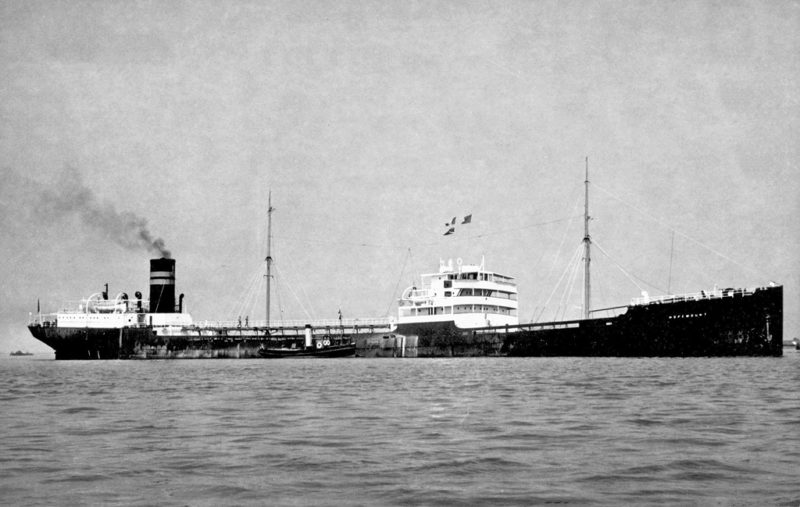
At the outbreak of WWI, Hopemount was being towed into Gibraltar with a broken high pressure cylinder, where it was patched up before she returned to the Tyne for repairs. Nine months later on 13th June 1915 she was captured by a submarine 70 miles SW of Lundy Island and sunk by gunfire.
In 1918 the subscribed capital of the company was increased to £53,000 in order to pay for two sister colliers being built at the Wallsend yard, Hopelyn and Hopecrest. The latter was sold on in 1919 to wear the famous ‘Black Diamond’ of William Cory & Sons Ltd. becoming their Corcrest. Hopelyn did some Mediterranean trading to Genoa, Savona, Susa and Philippeville as well as the more staple trade with North East coal to London. She was lost in this capacity on the Scrobie Sands off Norfolk on 19th October 1922 on a voyage to London with Tyne coal.
In November 1923 a 7,000 dwt tramp Hopeland was ready at the Whiteinch yard on the Clyde of Barclay, Curle & Co. Ltd., owned by Swan, Hunter. She was a five hold steam tramp with well-decks at nos. 1 and 5 holds and she commenced world-wide tramping:-
- 12.11.1923 Barry (coal), Genoa,Alexandria (cottonseed), Hull.
- 4.2.1924 Tyne (coal), Port Said, Novorossisk (grain), Liverpool.
- 5.5.1924 Barry (coal), Leghorn, Rosario & Buenos Aires (grain), Las Palmas, Genoa (ballast), New York (barley), Brake.
- 19.11.1924 Tyne (coal), Venice, Suez, Karachi (wheat), Hamburg.
- 16.3.1925 Barry (coal), Port Said, Barry.
- 25.4.1925 Barry (coal), Port Said, Barry.
- 11.6.1925 Barry (coal), Port Said, Tyne.
- 21.8.1925 Tyne (coal), Servola, Constantinople, Theodosia (grain), Constantinople, Rotterdam.
- 16.11.1925 Barry (coal), Santos, Sante Fe & Buenos Aires (grain), Las Palmas, Hamburg.
- 1.4.1926 Tyne (coa1), Servola, Novorossisk (grain), Algiers, Hamburg.
- 24.6.1926 Hamburg (ballast), Baltimore (coal), London.
- 14.8.1926 London, Hook of Holland, Charleston (coal), London.
- 3.10.1926 London (ballast), Newport News, Sheerness.
- 2.12.1926 Sheerness (ballast), Baltimore & Portland, Maine (coal), Hamburg.
- 14.2.1927 Tyne (coal), Civitavecchia, Kertch & Novorossisk (grain), Constantinople, Rotterdam.
- 31.5.1927 Cardiff (coal), Haifa, Alexandria (cottonseed), Hull, Tyne.
- 12.7.1927 Vessel left Tyne under new owners as Crown of Galicia.
The Wallsend-built motortramp Neptunian of 1925 was registered under the Hopemount Shipping Co. Ltd. with Stamp, Mann & Co. as managers. Arthur Stott & Co. took over as managers of the Hopemount Shipping Co. Ltd. in 1927, and Neptunian was then managed by W.A. Souter & Co. Ltd., Newcastle.
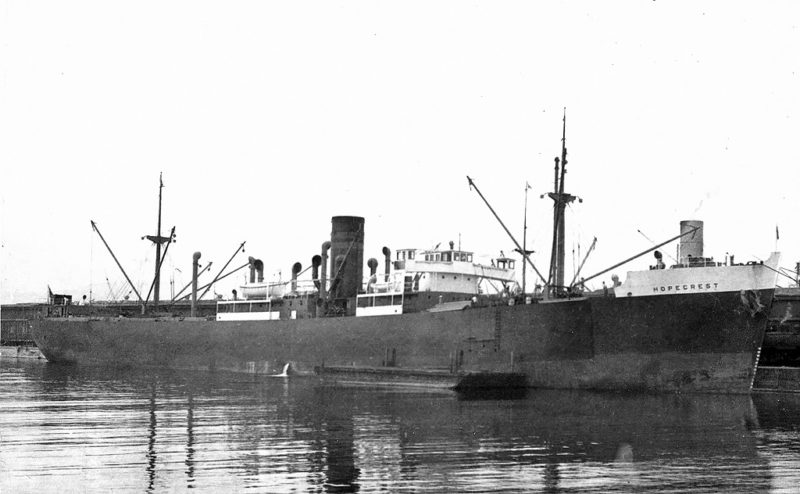
In 1927 the Hall Line cargo-liner City of Stockholm was purchased by Hopemount Shipping Co. Ltd. but immediately sold on to Howard, Tenens & Co. Ltd., London and renamed Prunus. Repurchased in 1932 she became Hopetor and was in the Newcastle fleet for five years before being sold to the South American Saint Line of Cardiff and renamed St. Merriel.

Two sister tramps of 6,000 dwt, Hopecrag and Hopedene, as well as an 11,000 dwt tanker Hopemount joined in 1929, all from the Swan, Hunter yard but Hopecrag and Hopedene came from their Southwick yard in Sunderland. The dry-cargo tramps were steamers but the tanker was a motorship. In 1932 they were joined by Hopetor and the purchased Harris & Dixon of London tramp Swanley, which had been built by Barclay, Curle & Co. Ltd. in 1924, and she was renamed Hoperange. Hopecrag and Hopedene could easily be distinguished from the purchased tramps by their raised centre islands and bridges. They were all kept going throughout the depression with only short lay-ups at the end of some voyages.
Arthur Stott & Co. were also managing at this time the sister tramps Benton and Kenton for the International South American S.S. Co. Ltd., as well as the Swan, Hunter built Murie S for the Monkseaton S.S. Co. Ltd.
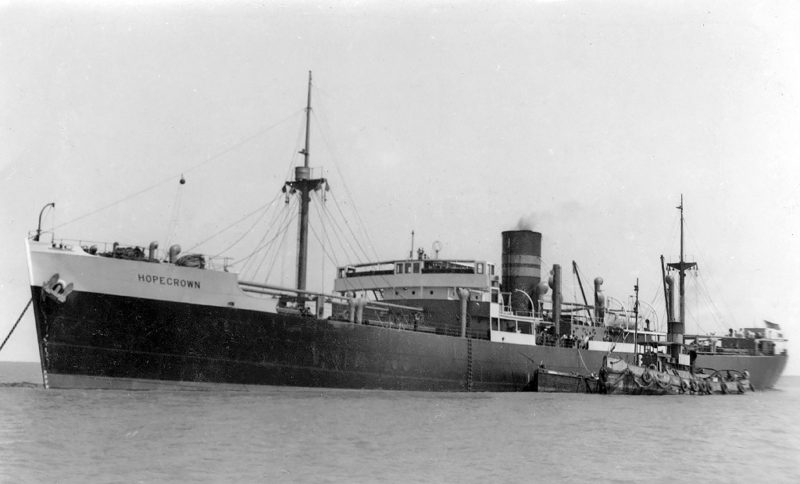
The management company title was changed to Stott, Mann & Fleming in 1938, in line with an expansion programme of eight new tramps which had been embarked upon with the rising freight rates in 1935. The motor tramp Hopecrest was ready in 1935 at the associated Barclay, Curle yard on the Clyde, and six more motor tramps followed from the Swan, Hunter yard in the next five years, Hopecastle, Hopecrown, Hopecreek, Hoperange, Hoperidge and Hopetarn as well as the steamer Hopestar of 1936. All were very similar and capable of lifting around 9,700 tons of heavy grain, and for this reason were fitted with steel, centre-line bulkheads (see above). Nos. 1,2,2a holds were forward of the engine room, aft being a large, deep tank again fitted with an oiltight, centre-line bulkhead and nos. 3 and 4 holds. The motor tramps had four cylinder Doxford-type opposed piston oil engines constructed at the Swan, Hunter Neptune Works and rated at 2,800 bhp to give a loaded service speed of 12 knots. Hopestarwas fitted with twin steam turbines.
Five of the new tramps were registered under the Hopemount Shipping Co. Ltd., but three single-ship companies were set up for Hopecrown, Hopecastle and Hopestar. These were Clive Shipping Co. Ltd., Novocastria Shipping Co. Ltd. and Wallsend Shipping Co. Ltd. respectively. At the launching ceremony in 1937 of the loyally-named Hopecrown telegrams were sent to his majesty King George VI and his new Queen commemorating his coronation and respectfully paying homage for a long and happy reign. The sister tramps became popular with liner companies, with Hopepeak even being taken on charter by Cunard!
Hopedene of 1929 was sold in 1938 to Stag Line becoming their Photinia, and her sister Hopecrag was also sold that year becoming Wyvern. The fleet at the outbreak of WWII thus comprised the large motor tanker Hopemount and eight dry-cargo tramps of which two were to become war losses:-
28.10.1942 Hopecastle Torpedoed and sunk near the Canary Islands
29.5.1943 Hopetarn Torpedoed and sunk off South African coast
Hopecastle was a member of the ill-fated SL 125 convoy of 37 ships from Fretown for the U.K. of which 12 never reached their destinations. She had loaded 2,500 tons of magnesite and ilmenite and 3,000 tons of tea and general cargo at Cochin in India, and was hit at 8 p.m. by a torpedo from a spread fired by U-509, one of which also sank the P & O Nagpore. She was abandoned at 9.15 p.m. that evening and five brave men had lost their lives. Hopetarn was torpedoed and sunk by U-198 some 600 miles East of of Durban while on a voyage from Calcutta and Colombo to Durban, Cape Town and the U.K. With 9,000 tons of general cargo and six crew lost their lives.
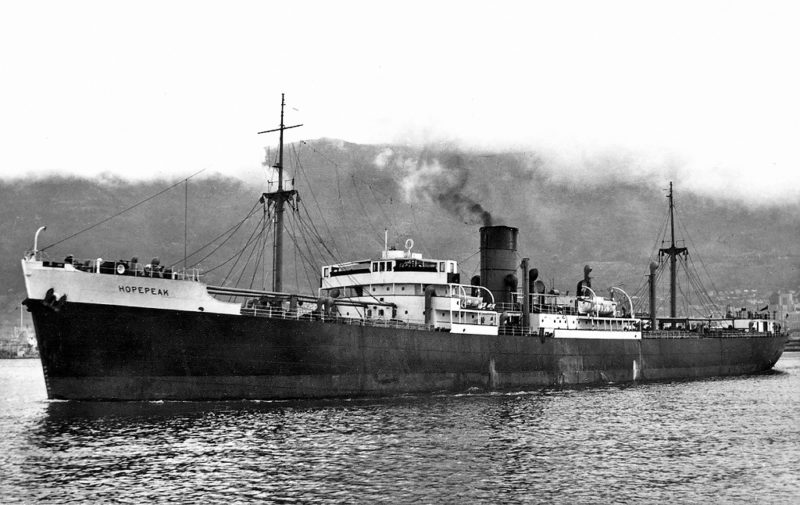
The motor tanker Hopemount was sold in 1945 to the Anglo-Saxon Petroleum Co. Ltd. and renamed Kelletia and traded in the Far Eastern and Western petroleum trades for 10 years before being sold to London owners and renamed Coral River and converted into a dry-cargo tramp. She finally ran aground in a typhoon at Hong Kong in September 1964 and was broken up there in 1965.
The remaining six dry-cargo tramps resumed their peacetime trades, and Hopestar left the Tyne on 3rd November 1948 in ballast for Philadelphia. She reported heavy weather damage on the 14th when 400 miles SE of Halifax, but extensive searches by aircraft and U.S. Coastguard ships failed to find any trace of her and the 40 crew. The Ministry of Transport inquiry in January 1949 concluded that the Hopestar was unseaworthy due to a combination of two weaknesses, the cutting of the bunker hatches when she was built, and the cutting back of the second deck just prior to her final voyage for the installation of a third boiler. It was agreed by naval architects that the original cutting of the hatches should have been compensated for by strengthening of the deck as her strength had been reduced to 84.3%, and although not unseaworthy she should have received attention, and the final cutting operation for the new boiler had weakened her much more seriously.
Hopecrown was sold in 1950 to fellow Newcastle tramp owners Stephens, Sutton & Co. Ltd. and renamed Radley for whom she traded for six years before being sold to Sweden. Ironically, Hopecrest and Hopepeak were sold in 1951/52 to the country that had tried so hard to sink them, Germany, thus leaving the 1939 pair Hoperange and Hoperidge to sail on until 1963 before being sold for further service. Hoperidge sailed from London in November 1951 with the biggest ever shipment of cars for Melbourne, a consignment of 800 Rootes Group cars and commercial vehicles worth £400,000 plus spare parts to the value of £150,000. Humber, Hillman and Sunbeam Talbot cars and Commer vans were shipped in boxed crates and chassis form. Hoperange caught fire in April 1957 off Balboa at the entrance to the Panama Canal, but the fire was put out and she proceeded to New Orleans to load. Here she ran aground and was stuck fast for several days and suffered hull damage. She was then towed across the Atlantic by a Dutch tug for repairs at Blyth. After ten months under repair at Blyth Capt. Sinclair and his crew were able to re-board Hoperange for further trading.
The management company title was changed from Stott, Mann & Fleming to Stott, Mann & Co. Ltd. in 1953, with Leslie Mann joining the Swan, Hunter directors on the Hopemount board. A new motor tanker Hopemount was ready in 1953 from the Wallsend yard. She was of 19,917 dwt and was taken on 10 year charter by Shell, and from 1962 wore the new funnel colours of yellow with a black top with a blue circle carrying ‘H’ for Hopemount.

Hoperidge and Hoperange also changed funnel colours during their last year of service with the company. Hopemount was then sold in 1963 to Liberian owners and renamed Consonance. She was back in the Tyne in September, 1967 after suffering a broken crankshaft while on a voyage from New York to Maracaibo in ballast. She was towed from Curacao to the Tyne by the Dutch tug Orinoco and the fitting of a new crankshaft took seven weeks at Smiths Dock Co. Ltd., North Shields. She was finally broken up at Kaohsiung in 1977.
A new 15,106 dwt trio of motor tramps was built at the Barclay, Curle yard on the Clyde between 1961-1963 for the Hopemount Shipping Co. Ltd. Hopecrest, Hopepeak and Hopecrag were fitted with five cylinder 7,500 bhp Sulzer oil engines constructed by the builder to give a service speed of 16 knots. Hopecreat at first wore the familiar twin brown bands on a black funnel, but the others were completed with the new funnel colours.
The Hopemount Shipping Co. Ltd. was taken over by Common Brothers on 10th June 1966 and the three motor tramps changed funnel colours again to the Common colours. They completed another three years service as Newcastle tramps before being sold in late 1969, with Hopecrest running aground in August 1969 in soft mud during a river transit at Shanghai but she came off undamaged.
Later her sister Hopecrag was to suffer considerable bow damage as Lord Hastings on 8th August 1979 when in collision 15 miles SW of Heligoland with the 228,970 dwt VLCC tanker Andros Titan. She had been at the end of a voyage from Karachi to Bremen and Rotterdam and was at first sold for scrap, then reprieved and repaired and gave another five years service before being scrapped in China in 1985.
Her sisters were also scrapped at this time, and there are no survivors left today of this interesting tramp company started by a shipyard.
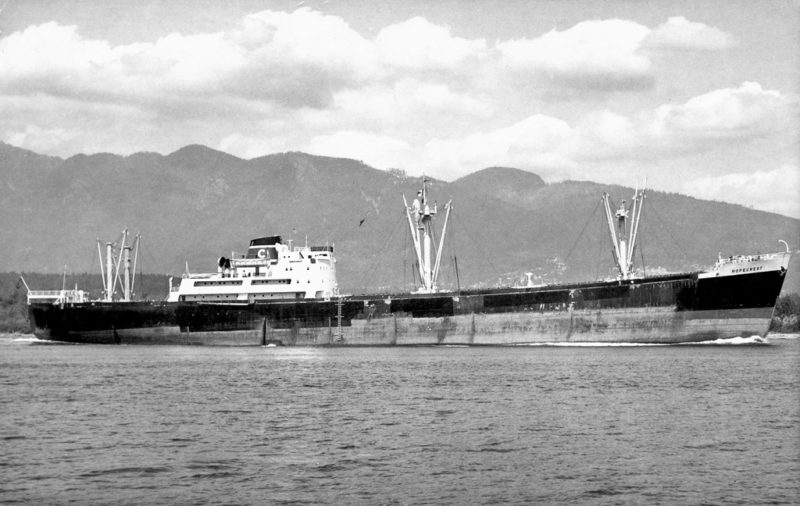
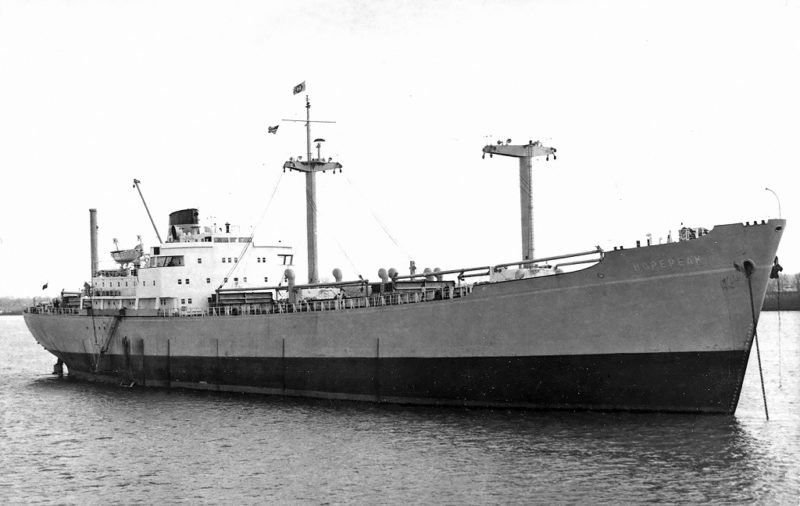


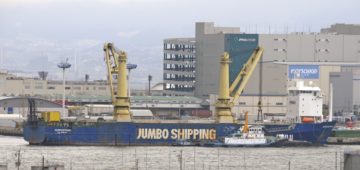



Comments
Sorry, comments are closed for this item